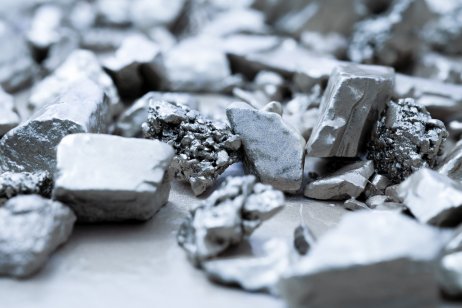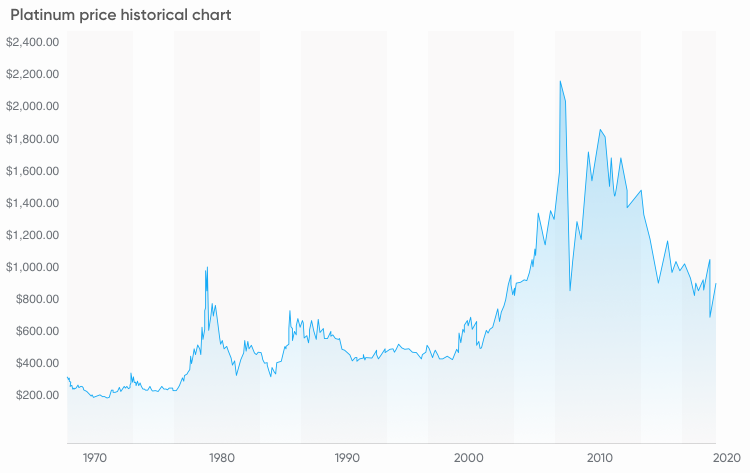Platinum price forecast 2020 and beyond: will the metal ever shine again?
17:08, 24 June 2020

Platinum as an investment instrument has a much shorter history than gold or silver, which roots of trading trace back to ancient civilisations. However, it has already established itself as a great addition to a savvy investor’s portfolio.
But while the commodity had a quite spectacular rally between 1999 and 2008, and managed to recover rather quickly after the Great Recession, it has been gradually shedding in value since 2012.
With a troy ounce of metal bottoming out at $558 in March 2020 and hiking to trade at around $840 in June, where is this precious metal heading next? Will platinum prices rise further to surpass their previous highs or will they fall off the cliff to set new record lows?
In the article, we try to find the truth by analysing the metal’s historical value fluctuations and key drivers influencing its movements, as well as checking out the latest platinum price forecast for the rest of 2020 and beyond.
Platinum price trend: is the metal still precious?
Back in the day, platinum was widely perceived as a well-performing long-term investment, best suited for those who are able to weather short-term volatility and who appreciate the metal’s precious underpin coupled with its growing industrial demand. But is platinum a good investment now?
To have a better understanding of what the platinum price outlook might look like going forward, it is important to know how this commodity has performed in the past.

From the late 1990s up until the infamous financial crisis of 2008, platinum’s robust performance was mainly driven by the metal’s constrained supply, diversity of application and effective demand stimulation. In March 2008, the commodity reached its record high of $2,273 per troy ounce (t oz). However, it lost over 65 per cent within a few months as the economic situation worsened, falling to $774/t oz in November 2008.
Unlike many other financial assets, the precious metal quickly swung back into the uptrend, eventually hitting another peak of $1,874/t oz in August 2011. It was then that platinum started to fall sharply, experiencing multiple price fluctuations along its way. By January 2016, the metal was changing hands at $820/t oz.
In the next few months, the commodity recovered some of its losses and, during summer 2016, reached a value of $1,158/t oz.
In August 2018, platinum hit its 10-year low at $777.30/t oz, only to hike back to the $1,024.80 mark in January 2020. However, the bullish momentum was short-lived, and for the platinum price, 2020 has proven to be anything but a good year so far.
After the Covid-19 pandemic has hit the world, bringing to a halt industrial activity and hampering global economic growth, the shiny metal recorded its worst quarterly performance since 2008 in the first three months of this year. Driven by the fear of another market crash, many investors rushed to unload precious metals in exchange for cash. Possibility of a collapse in physical demand from the automotive sector added fuel to the fire, with the platinum price plunging sharply from $1,016/t oz on February 19 to below $600/t oz on March 19.
Platinum price news turned bullish at the end of March when the world’s largest producers went into lockdown in South Africa, leading to a short-term supply easing. By May 20, the value of the commodity reached $934.50/t oz. However, the price again slid lower and hovered around the $800/t oz mark at the time of writing, on June 24.
What is your sentiment on Silver?
What drives the value of platinum today?
Like all commodities, it is a complex mix of supply and demand fundamentals that influence the value of platinum. However, the specifics of this particular market are rather unique.
The metal’s supply is unusually concentrated, with South Africa producing around 75 per cent of the world’s newly mined platinum. As a result, any economic or political turbulence in the region may cause a supply disruption, determining the metal’s prices.
In recent years, platinum production in the country has suffered from issues like labour disputes and instability of the South African rand. In addition to existing problems, the coronavirus outbreak forced large producers like Impala Platinum and Anglo American Platinum to stay closed, due to lockdown measures.
But if production was stalled for a while in spring, causing fear of supply shock and allowing the prices to partially recover their previous losses, why hasn’t the metal skyrocketed yet?
The answer lies in the latest demand tendencies.
Platinum has found its applications in a number of various industries, with the automotive sector remaining a key consumer of the metal. For that, platinum prices are largely determined by auto production and sales figures.

Before the outbreak of the virus, the automotive industry was already under pressure, with vehicle sales slowing globally in 2019. The Volkswagen “Dieselgate” emissions scandal, which made headlines in 2015, has been particularly devastating for the platinum market. Once the EU introduced tighter restrictions on polluting cars, palladium-backed petrol cars have become more popular.
On the bright side, as palladium is now much more expensive, there might be a chance that some manufacturers will decide to go back to use platinum in their petrol vehicles. However, this shift could take months, if not years, to happen.
In any way, the pandemic has caused a significant drop in automotive demand. And if the second wave of coronavirus infections is to happen, this negative trend is likely to prevail in the short term, outweighing the gains from supply disruptions.
While the prospects of the metal’s future look anything but optimistic, what do analysts have to say?
Platinum price forecast: will the metal continue to lose its splendid shine?
Historically, platinum had always been almost one-third more expensive than gold. However, it currently trades at near all-time low relative to its yellow peer. Is now a good time to buy the white metal at a discount? Will platinum prices go up in the second half of 2020?
Market experts have split in two in their platinum price prediction.
Before the pandemic even happened, analysts from Capital Economics forecast the value of the metal to stay “firmly in the doldrums” over the next few years against the background of “a weaker South African rand coupled with the high prices of by-products at platinum mines”.
On the other hand, the latest positive news from BASF (BAS) could provide much-needed support to the prices. In March, the German chemicals manufacturer reported that along with Implats and Sibanye-Stillwater, it has developed and tested a new catalyst that would allow it to partially replace higher-priced palladium with cheaper platinum in light-duty gasoline vehicles.
On the news, Implats CEO Nico Muller commented: “We are proud to have contributed to a solution which will normalise longer-term demand with supply and benefit all members of the value chain from miners, to refiners, fabricators and OEMs.”
Commenting on the event, NOAH Capital Markets’ analyst Rene Hochreiter noted: “There are still 3.6 million ounces of above-ground stocks of platinum, so it will take a bit of time before that is worked through, but it will still benefit the platinum price with the extra demand for platinum.”
Last year, Hochreiter also said that “the outlook for PGM miners is better than it has been for many years. The whole PGM market is going into a massive deficit – 10 baggers will come.”
In the meantime, Stephen Forrest, Executive Chairman of SFA Oxford, has a less bullish view on the future of the commodity. During the PGM Industry Day conference held in 2019, he said: “Looking out five to ten years the South African mines’ output will consist of about 58 per cent platinum, 34 per cent palladium, and 8 per cent rhodium. The demand mix over this period is for between 50 per cent to 60 per cent palladium, but only about 40 per cent platinum and about 6 per cent rhodium.”
“Future demand does not favour the South African PGM production mix right now,” Forrest added, reminding that the metal remains heavily oversupplied.
The World Platinum Investment Council forecasts that in 2020, there will be a total surplus of 247,000 ounces, which is 128,000 ounces higher than its previous estimates. Supply is expected to be down 13 per cent, year-on-year, while demand is anticipated to be 18 per cent lower than in 2019 mainly on weak jewellery and automotive sales, as well as lower investment demand.
On the flip side, Paul McFadyen, Managing Director of metals4U, a British diversified metal distributor, previously said that giving a certain platinum forecast is difficult due to the commodity’s ever-evolving uses: “Although the more ‘traditional’ uses for platinum may be in decline, I predict that the value of platinum will increase and be maintained within newer industry demand.”
McFadyen explained: “The future of platinum is looking bright as other market areas are experiencing development and growth. The use of platinum within the chemicals industry, electronics, avionics, and glass manufacturing industries, for example, will maintain their demand for the precious metal.”
A few weeks ago, Metals Focus, one of the world’s leading independent precious metals consultancies, published its platinum price forecast for 2020. Their analysts predicted the metal’s price to average at $765/t oz this year, a figure 11 per cent lower year-over-year, reflecting an ongoing market surplus.
According to Walletinvestor.com, an online forecasting service, the metal is expected to trade downwards, closing 2020 at $765.075/t oz and mainly remaining under the $800 level in the following years. By December 2024, the commodity is predicted to fall as low as $620.546/t oz.
This is what their platinum price forecast 2020 - 2021 looks like:

Based on the data provided by Trading Economics, platinum is anticipated to trade at $786.97/t oz by the end of this quarter, with the metal’s value plunging to $706.28/t oz in 12 months.

To invest, or not to invest?
Just like with any other financial instrument, opening a position in platinum gives no guarantee of success. The commodity is a quite risky asset, so it may not be the best idea to throw all of your cash in this precious metal, especially if you are interested in the short-term investments and quick profits. However, platinum might be a good long-term addition to your well-diversified portfolio.
